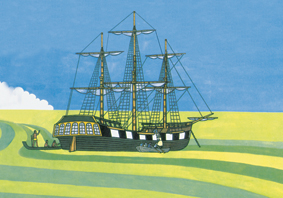 |
The
assessments included eight tasks investigating students’
knowledge, understandings and processes in the area of time, continuity
and change. This area focuses on relationships between people
and events through time, and the interpretation of these relationships.
Five tasks were identical for both year 4 and year 8 students
and three were administered only to year 8 students. Two are trend
tasks (fully described with data for both 2001 and 2005), two
are released tasks (fully described with data for 2005 only) and
four are link tasks (to be used again in 2009, so only partially
described here).
|
The tasks are presented in the three sections: trend tasks, then
released tasks and finally link tasks. Within each section, tasks
attempted by both year 4 and year 8 students are presented first,
followed by tasks attempted only by year 8 students.
Averaged across 28 task components administered to both year 4
and year 8 students, 23 percent more year 8 than year 4 students
succeeded with these components. Year 8 students performed better
on 25 of the 28 components.
There was evidence of useful improvement between 2001 and 2005
on the single trend task for year 4 students and the two trend
tasks for year 8 students. Because the improvements were mainly
associated with four components of a single task (Rodney’s
Window), these results should be interpreted with caution.
Averaged across the four trend task components attempted by year
4 students in both years, nine percent more students succeeded
in 2005 than in 2001. Gains occurred on all four components. At
year 8 level, with 15 trend task components included, seven percent
more students succeeded in 2005 than in 2001. Gains occurred on
12 of the 15 components.
Most students at both year levels could identify visible changes
that had occurred across time. Year 8 students were much better
able than year 4 students to explain good and bad implications
of these changes for people living in the different times. Substantial
numbers of year 8 students showed significant knowledge of New
Zealand history, but only a minority had reasonable knowledge
of the timing of major events. Understandably, year 4 students
had very limited historical knowledge. About half of year 8 students
could talk about one or more current world issues, with most of
the remainder mentioning at least one national or local issue
instead. Faced with the same task, about half of the year 4 students
were not able to articulate any relevant issue (local, national
or international). |